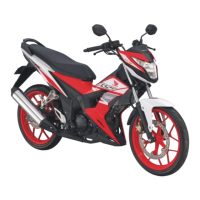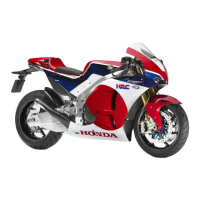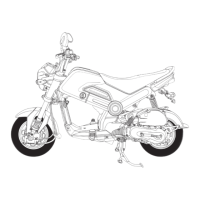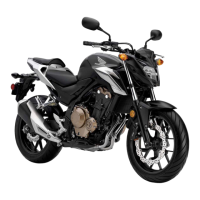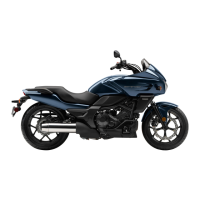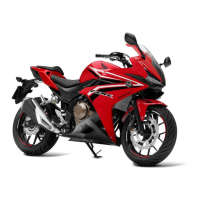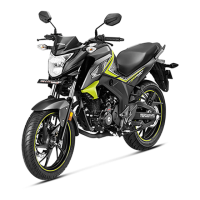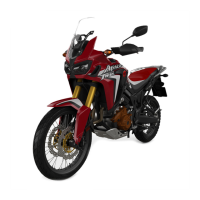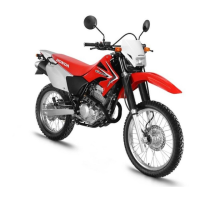Do you have a question about the Honda RS150R 2016 and is the answer not in the manual?
Provides fundamental safety rules for operating the motorcycle, covering pre-ride checks and general advice.
Lists key safety precautions for riding, including protective apparel and passenger safety.
Details essential precautions for safe riding practices like braking, parking, and riding conditions.
Advises on the safe use of accessories and modifications to maintain safety.
Provides guidance on proper loading to maintain motorcycle stability and handling.
Emphasizes the importance of helmets, eye protection, and high-visibility clothing.
Outlines essential checks before starting the engine for safe operation.
Recommends practice for new riders and familiarity with the bike's handling.
Advice on being aware of other traffic and potential hazards for safe riding.
Tips to make yourself more visible to other road users, especially at night.
Guidance on riding according to personal abilities and prevailing conditions.
Strongly advises against drinking and riding for safety.
Highlights the importance of regular maintenance for safe operation.
Steps to take if involved in a motorcycle accident for personal safety.
Warns about the dangers of carbon monoxide from exhaust fumes in enclosed areas.
Details requirements for helmets, gloves, boots, and protective apparel.
Recommendations for the first 500 km of motorcycle operation for reliability.
Guidelines for safe and effective brake usage, including downshifting.
Explains how to use engine braking for slowing down, especially on slopes.
Advises on extra caution needed in wet weather for braking and traction.
Instructions for parking safely on various surfaces and securing the motorcycle.
Guidance on deploying the side and centre stands correctly.
Recommendations for safe and proper refuelling practices and fuel types.
Warns against unauthorized accessories and modifications that can cause crashes.
Explains how load affects motorcycle handling, braking, and stability.
Instructions for securely and evenly balancing luggage for safe riding.
Identifies key engine parts and front controls like levers and reservoirs.
Locates major chassis parts, rider controls, and storage compartments.
Details the tachometer function, its readings, and the red zone warning.
Instructions for verifying instrument display functionality when ignition is on.
Explains the use of the SEL button for switching between odometer and tripmeter.
Describes the speedometer readings and how gear position is displayed.
Explains the function of odometers, tripmeters, and the fuel gauge indicators.
Details high beam, left/right turn signal, and neutral indicators.
Explains the function and warning conditions of the high coolant temperature indicator.
Describes the PGM-FI system malfunction indicator light and actions to take.
Operation of the ignition switch, start button, and horn button.
Functionality of turn signal and headlight dimmer controls.
Explains turning the electrical system on/off and locking the steering.
Step-by-step guide to locking and unlocking the motorcycle's steering for theft prevention.
Instructions for closing the ignition switch shutter manually or automatically.
Procedure for starting the engine using the electric start button.
Procedure for starting the engine using the kickstarter.
Describes the motorcycle's 6-speed, one-down, five-up gear shift pattern.
Step-by-step guide to opening the fuel tank cap for refuelling.
Instructions for securely closing the fuel tank cap after refuelling.
Instructions for opening and closing the seat using the ignition key.
Location and use of helmet holders found under the seat.
Details the storage location of the owner's manual, documents, and tool kit.
Highlights the necessity of pre-ride checks for safety and preventing breakdowns.
Explains the purpose and importance of the maintenance schedule for performance.
Guidance on choosing and verifying engine oil specifications based on standards.
Information on recommended brake fluid type and drive chain inspection.
Procedures for cleaning, lubricating the chain, and recommended coolant use.
Instructions for checking and maintaining proper tyre air pressure for safety.
Guidance on checking tyres for cuts, cracks, and abnormal wear patterns.
Details on checking tread wear indicators and minimum depth for safe riding.
Advises servicing the air cleaner by a dealer due to its specific viscous type.
Lists the tools provided in the kit for minor repairs and adjustments.
Detailed procedure for removing and installing the motorcycle battery.
Steps for removing and reinstalling the centre lower cowl assembly.
Instructions for removing and installing various types of clips.
Procedure for removing and reinstalling the right side cowl.
How to remove and install the harness band clip securely.
Steps for removing and reinstalling the right side cover.
Guide to inspecting, cleaning, and replacing the spark plug.
Procedure for checking the engine oil level using the dipstick.
Instructions on how to add engine oil if the level is low.
Steps for draining and refilling the engine oil with proper torque.
Procedure for checking coolant level in the reserve tank and adding fluid.
Recommendations for changing the coolant, often requiring dealer service.
Guide to checking front and rear brake fluid reservoirs for proper levels.
How to check brake pad wear indicators for timely replacement.
Procedure for adjusting the brakelight switch timing for safety.
Ensuring the side stand operates smoothly and checking the spring tension.
How to check and measure the correct drive chain slack.
Step-by-step guide to adjusting the drive chain tension and alignment.
Identifying excessive wear and determining when the chain needs replacement.
How to measure and check the freeplay of the clutch lever for proper engagement.
Procedure for adjusting the clutch lever freeplay for smooth operation.
Ensuring smooth throttle rotation and correct freeplay for control.
Procedure for cleaning the crankcase breather tube and draining deposits.
How to adjust the headlight's vertical aim for proper alignment and road visibility.
Addresses issues when the engine will not start, covering starter and fuel.
Diagnosing overheating issues indicated by the coolant temperature light.
Explains PGM-FI and other warning indicators on the dashboard.
Covers tyre punctures, emergency repairs, and wheel removal procedures.
Addresses battery issues, burnt-out bulbs, and blown fuses.
Troubleshooting steps when the starter motor works but the engine fails to start.
Troubleshooting steps when the starter motor does not engage.
Recognizing signs of overheating and performing initial checks.
Action to take if the PGM-FI indicator light comes on while riding.
Explains how fuel gauge errors are displayed and recommends dealer service.
Guidelines for using a temporary tyre repair kit for minor punctures.
General procedures for removing and installing front and rear wheels.
Step-by-step instructions for removing the front wheel assembly.
Step-by-step instructions for installing the front wheel assembly correctly.
Step-by-step instructions for removing the rear wheel assembly.
Step-by-step instructions for installing the rear wheel assembly correctly.
Guidance on charging a dead motorcycle battery using appropriate chargers.
Procedures for replacing various motorcycle light bulbs.
Steps for inspecting and replacing blown fuses in the fuse box.
Instructions for replacing headlight and brakelight/taillight bulbs.
Procedure for replacing front and rear turn signal bulbs.
How to replace position and license plate light bulbs.
Addresses unstable engine operation possibly due to fuel pump filter clogging.
Information on ignition keys, ignition switch, and related systems.
Overview of the instrument panel, controls, and other motorcycle features.
Guidelines for cleaning, washing, and general care of the motorcycle.
Advice on storing and transporting the motorcycle safely.
Information on responsible cleaning and waste disposal for environmental protection.
Details on locating and recording frame and engine serial numbers.
Information on using appropriate fuels, including alcohol blends.
Advice on maintaining the catalytic converter for optimal performance.
Guidance on recording key numbers, storing spare keys, and obtaining duplicates.
Details on ignition switch operation and the ignition cut-off system.
Functions of the odometer, tripmeter, and the location of the document bag.
Explanation of high beam and headlight indicator behavior.
Step-by-step guide to washing the motorcycle correctly to ensure its life.
Advice on avoiding water damage to air cleaner, muffler, and electrical parts.
Instructions for cleaning aluminium components and painted panels to prevent scratches.
Guidance on cleaning painted exhaust pipes and mufflers using neutral detergents.
Steps for preparing the motorcycle for long-term storage, including battery care.
Advice on using trailers and tie-down straps for secure motorcycle transport.
Recommends biodegradable detergents and avoids CFCs for ozone layer protection.
Guidance on recycling hazardous wastes like oil and solvents to protect the environment.
Instructions for finding and recording motorcycle serial numbers for registration.
Information on using ethanol blends and potential risks to the fuel system.
Advice on using unleaded fuel and maintaining engine condition for converter health.
Lists key dimensions, weight, capacity, and engine specifications.
Details on tyre size, pressure, spark plugs, oils, and fluids.
Information on bulb types, fuse ratings, and torque values for maintenance.
Provides fundamental safety rules for operating the motorcycle, covering pre-ride checks and general advice.
Lists key safety precautions for riding, including protective apparel and passenger safety.
Details essential precautions for safe riding practices like braking, parking, and riding conditions.
Advises on the safe use of accessories and modifications to maintain safety.
Provides guidance on proper loading to maintain motorcycle stability and handling.
Emphasizes the importance of helmets, eye protection, and high-visibility clothing.
Outlines essential checks before starting the engine for safe operation.
Recommends practice for new riders and familiarity with the bike's handling.
Advice on being aware of other traffic and potential hazards for safe riding.
Tips to make yourself more visible to other road users, especially at night.
Guidance on riding according to personal abilities and prevailing conditions.
Strongly advises against drinking and riding for safety.
Highlights the importance of regular maintenance for safe operation.
Steps to take if involved in a motorcycle accident for personal safety.
Warns about the dangers of carbon monoxide from exhaust fumes in enclosed areas.
Details requirements for helmets, gloves, boots, and protective apparel.
Recommendations for the first 500 km of motorcycle operation for reliability.
Guidelines for safe and effective brake usage, including downshifting.
Explains how to use engine braking for slowing down, especially on slopes.
Advises on extra caution needed in wet weather for braking and traction.
Instructions for parking safely on various surfaces and securing the motorcycle.
Guidance on deploying the side and centre stands correctly.
Recommendations for safe and proper refuelling practices and fuel types.
Warns against unauthorized accessories and modifications that can cause crashes.
Explains how load affects motorcycle handling, braking, and stability.
Instructions for securely and evenly balancing luggage for safe riding.
Identifies key engine parts and front controls like levers and reservoirs.
Locates major chassis parts, rider controls, and storage compartments.
Details the tachometer function, its readings, and the red zone warning.
Instructions for verifying instrument display functionality when ignition is on.
Explains the use of the SEL button for switching between odometer and tripmeter.
Describes the speedometer readings and how gear position is displayed.
Explains the function of odometers, tripmeters, and the fuel gauge indicators.
Details high beam, left/right turn signal, and neutral indicators.
Explains the function and warning conditions of the high coolant temperature indicator.
Describes the PGM-FI system malfunction indicator light and actions to take.
Operation of the ignition switch, start button, and horn button.
Functionality of turn signal and headlight dimmer controls.
Explains turning the electrical system on/off and locking the steering.
Step-by-step guide to locking and unlocking the motorcycle's steering for theft prevention.
Instructions for closing the ignition switch shutter manually or automatically.
Procedure for starting the engine using the electric start button.
Procedure for starting the engine using the kickstarter.
Describes the motorcycle's 6-speed, one-down, five-up gear shift pattern.
Step-by-step guide to opening the fuel tank cap for refuelling.
Instructions for securely closing the fuel tank cap after refuelling.
Instructions for opening and closing the seat using the ignition key.
Location and use of helmet holders found under the seat.
Details the storage location of the owner's manual, documents, and tool kit.
Highlights the necessity of pre-ride checks for safety and preventing breakdowns.
Explains the purpose and importance of the maintenance schedule for performance.
Guidance on choosing and verifying engine oil specifications based on standards.
Information on recommended brake fluid type and drive chain inspection.
Procedures for cleaning, lubricating the chain, and recommended coolant use.
Instructions for checking and maintaining proper tyre air pressure for safety.
Guidance on checking tyres for cuts, cracks, and abnormal wear patterns.
Details on checking tread wear indicators and minimum depth for safe riding.
Advises servicing the air cleaner by a dealer due to its specific viscous type.
Lists the tools provided in the kit for minor repairs and adjustments.
Detailed procedure for removing and installing the motorcycle battery.
Steps for removing and reinstalling the centre lower cowl assembly.
Instructions for removing and installing various types of clips.
Procedure for removing and reinstalling the right side cowl.
How to remove and install the harness band clip securely.
Steps for removing and reinstalling the right side cover.
Guide to inspecting, cleaning, and replacing the spark plug.
Procedure for checking the engine oil level using the dipstick.
Instructions on how to add engine oil if the level is low.
Steps for draining and refilling the engine oil with proper torque.
Procedure for checking coolant level in the reserve tank and adding fluid.
Recommendations for changing the coolant, often requiring dealer service.
Guide to checking front and rear brake fluid reservoirs for proper levels.
How to check brake pad wear indicators for timely replacement.
Procedure for adjusting the brakelight switch timing for safety.
Ensuring the side stand operates smoothly and checking the spring tension.
How to check and measure the correct drive chain slack.
Step-by-step guide to adjusting the drive chain tension and alignment.
Identifying excessive wear and determining when the chain needs replacement.
How to measure and check the freeplay of the clutch lever for proper engagement.
Procedure for adjusting the clutch lever freeplay for smooth operation.
Ensuring smooth throttle rotation and correct freeplay for control.
Procedure for cleaning the crankcase breather tube and draining deposits.
How to adjust the headlight's vertical aim for proper alignment and road visibility.
Addresses issues when the engine will not start, covering starter and fuel.
Diagnosing overheating issues indicated by the coolant temperature light.
Explains PGM-FI and other warning indicators on the dashboard.
Covers tyre punctures, emergency repairs, and wheel removal procedures.
Addresses battery issues, burnt-out bulbs, and blown fuses.
Troubleshooting steps when the starter motor works but the engine fails to start.
Troubleshooting steps when the starter motor does not engage.
Recognizing signs of overheating and performing initial checks.
Action to take if the PGM-FI indicator light comes on while riding.
Explains how fuel gauge errors are displayed and recommends dealer service.
Guidelines for using a temporary tyre repair kit for minor punctures.
General procedures for removing and installing front and rear wheels.
Step-by-step instructions for removing the front wheel assembly.
Step-by-step instructions for installing the front wheel assembly correctly.
Step-by-step instructions for removing the rear wheel assembly.
Step-by-step instructions for installing the rear wheel assembly correctly.
Guidance on charging a dead motorcycle battery using appropriate chargers.
Procedures for replacing various motorcycle light bulbs.
Steps for inspecting and replacing blown fuses in the fuse box.
Instructions for replacing headlight and brakelight/taillight bulbs.
Procedure for replacing front and rear turn signal bulbs.
How to replace position and license plate light bulbs.
Addresses unstable engine operation possibly due to fuel pump filter clogging.
Information on ignition keys, ignition switch, and related systems.
Overview of the instrument panel, controls, and other motorcycle features.
Guidelines for cleaning, washing, and general care of the motorcycle.
Advice on storing and transporting the motorcycle safely.
Information on responsible cleaning and waste disposal for environmental protection.
Details on locating and recording frame and engine serial numbers.
Information on using appropriate fuels, including alcohol blends.
Advice on maintaining the catalytic converter for optimal performance.
Guidance on recording key numbers, storing spare keys, and obtaining duplicates.
Details on ignition switch operation and the ignition cut-off system.
Functions of the odometer, tripmeter, and the location of the document bag.
Explanation of high beam and headlight indicator behavior.
Step-by-step guide to washing the motorcycle correctly to ensure its life.
Advice on avoiding water damage to air cleaner, muffler, and electrical parts.
Instructions for cleaning aluminium components and painted panels to prevent scratches.
Guidance on cleaning painted exhaust pipes and mufflers using neutral detergents.
Steps for preparing the motorcycle for long-term storage, including battery care.
Advice on using trailers and tie-down straps for secure motorcycle transport.
Recommends biodegradable detergents and avoids CFCs for ozone layer protection.
Guidance on recycling hazardous wastes like oil and solvents to protect the environment.
Instructions for finding and recording motorcycle serial numbers for registration.
Information on using ethanol blends and potential risks to the fuel system.
Advice on using unleaded fuel and maintaining engine condition for converter health.
Lists key dimensions, weight, capacity, and engine specifications.
Details on tyre size, pressure, spark plugs, oils, and fluids.
Information on bulb types, fuse ratings, and torque values for maintenance.
| Displacement | 149.16 cc |
|---|---|
| Bore x Stroke | 57.3 mm x 57.8 mm |
| Compression Ratio | 11.3:1 |
| Transmission | 6-Speed |
| Fuel System | PGM-FI (Programmed Fuel Injection) |
| Front Suspension | Telescopic fork |
| Front Brake | Hydraulic disc |
| Rear Brake | Hydraulic disc |
| Fuel Tank Capacity | 4.5 liters |
| Seat Height | 764 mm |
| Max Torque | 13.5 Nm @ 6, 500 rpm |
| Ignition System | Full Transistorized |
| Starter | Electric |
| Final Drive | Chain |
| Front Tire | 90/80-17 |
| Rear Tire | 120/70-17 |
| Max Power | 11.5 kW (15.6 PS) @ 9, 000 rpm |
